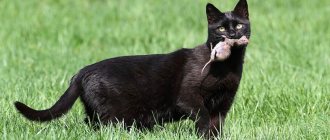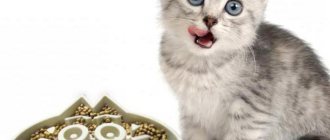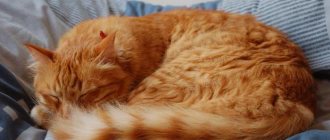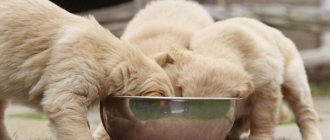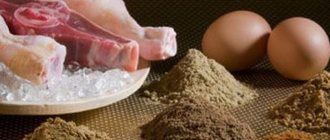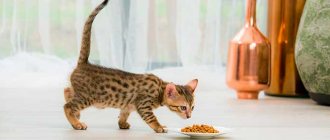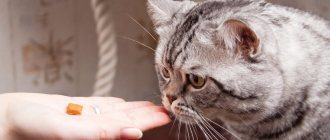Natural or balanced food for adult cats?
Many cat owners choose dry food for cats and kittens, but some remain committed to the misconception about the benefits of raw meat, fish and fresh dairy products. Myths about the benefits of “natural food” for felines have long been dispelled by veterinarians, manufacturers of pet diets, and store specialists in the selection and sale of all types of food. Compared to meat, fish and other products, ready-made pelleted feeds have many advantages:
- Balanced – dry cat food should consist of proteins, fats, carbohydrates, digestible fiber, and a vitamin-mineral complex; it is best to purchase them in specialized online stores.
- Easy dosage according to the age and weight of the animal;
- Ease of combination of dry/wet food and traditional products;
- Elimination of poisoning, which often occurs when feeding meat/fish with a large amount of premixes;
- The ability to choose daily, preventive and therapeutic dry food for cats of any age group.
How to prepare natural food for a cat for a month
You can continue to feed the animal its usual food, gradually mixing in various ingredients of another product until a complete replacement occurs. The new type of food should be given to the animal in small quantities in small pieces, no different in size from normal everyday food. After 4-5 days, the volume of dry food is reduced to 50%, then the replacement occurs completely within 10-15 days.
If the pet prefers certain products in addition to dry food, temporarily limit them only to them until the cat is completely weaned from “drying”.
If it is difficult to determine your pet’s taste preferences, it is worth offering several different dishes, placing them in different bowls. The cat will choose and take a liking to the new food, then the cat will be completely switched to homemade food.
There is an option when the volume of regular food is reduced, and the animal, without being completely full, is saturated with another product, homemade, located close to the main, regular food.
Usually, a cat’s refusal of new food plunges the owners into panic - they worry that the pet will become exhausted, get sick, or die. But the animal will not die of hunger if there is food nearby, even if it is tasteless and unloved. Fears are unfounded, remember that you are acting for the benefit of your pet, the cat will humble itself and accept your conditions.
The main product in this type of diet is meat, about 80%. The rest is cereals, vitamins, vegetable supplements. Natural feeding requires an accurate calculation of the daily food intake; the idea that the cat itself knows how much it needs to eat is wrong. Often, fluffy beauties, without knowing the limits, gobbling up delicious foods on both cheeks, acquire excess weight, heart and respiratory problems. Different ages are taken into account when compiling the daily menu.
Two and a half months is the age that allows you to separate the baby from the mother. Before nine months, the kitten should receive no more than 10% of its weight in food. With a weight of 2000 g, the weight of the daily portion is 200 g. 50% is meat food, 50% is fish products.
An adult animal needs only 5% of its weight in feed. For an animal weighing 5 kg – 250 g of natural food, consisting of equal parts of fermented milk and meat products. 20 g of vegetables and a few drops of vegetable oil are allowed. Active pets that spend a lot of energy are given more food, inactive, obese, and elderly pets require less.
READ Worms in goats treated with folk remedies - All about the garden
The reasons why you need to switch your cat to a different diet may be the following:
- transition of an animal to another age group. A kitten, an adult cat and a cat or an already aging pet have their own nutritional requirements. Therefore, as your pet gets older, the need to change its diet will arise at least twice;
- cat pregnancy. In this state, the female needs more vitamins and nutrients into her body. Experts recommend switching pregnant cats to special food;
- postoperative recovery period (for example, after castration and sterilization). During rehabilitation, the risk of your pet gaining extra pounds increases. Therefore, veterinarians prescribe special food for animals;
- the pet has an individual intolerance to any product or component. This condition is characterized by the development of food allergies, which requires careful selection of food;
- disease. The disease weakens the pet, so he must follow a special diet prescribed by the veterinarian. In this case, independent selection of food is prohibited;
- Your pet's favorite food has been discontinued.
Some breeders recommend changing your cat's food 3 times a year to reduce the risk of developing food allergies. But if the animal feels normal and does not suffer from digestive disorders, then you can refrain from such actions.
Soups, broths, milk are not food for predators who are used to gnawing and chewing. Cats living in villages eat small rodents, birds, fish, insects, and sometimes fresh grass.
Soups, broths, milk are not food for predators who are accustomed to gnawing and chewing.
Such food replenishes the cat's body with the necessary nutrients.
The home diet should contain:
- Proteins (50%). This is raw lean meat and fish, cottage cheese, fermented milk products, as well as liver, stomachs, and heart. Meat and fish products should be frozen to prevent the animal from becoming infected with parasites.
- Fats (35%). They are found in meat, and sources of vegetable fats can be wheat and corn.
- Carbohydrates (10%). Porridge, vegetables, fruits.
- Food additives (5%). Bone meal, oils, vitamins. Sources of vitamins will be fresh fruits, legumes, and green grass. You can purchase vitamin complexes in veterinary pharmacies, but strictly as prescribed by a specialist. The addition of bifidobacteria will contribute to the restructuring of digestion.
Food in the form of minced meat is not suitable for cats - they swallow meat in pieces according to their size. This does not harm the animals - this is their physiology.
You can add a little chopped lettuce, broccoli, pumpkin, beets, zucchini, and carrots to the finely chopped meat. Taboos for cats are eggplants and tomatoes in any form. These vegetables can lead to food poisoning.
Be sure to read:
Can cats have sweets: when is it necessary, in what form is it allowed, benefits and harms, why not?
Transitioning adult cats to dry food
In this review, we will not compare the pros and cons of ready-made food, but will take it as a constant that you have decided to switch your pet to dry food.
It is important to choose the “right” food and teach the animal to eat exactly the food that you have chosen (or the veterinarian prescribed to you). But while it is relatively easy to accustom kittens to dry nutritious foods, changing the taste preferences of an adult will require maximum effort and patience. We recommend considering the following aspects:
- Selection of quality products - it is important to initially buy high-quality dry cat food (Royal Canin, Purina, Pro Plan, IAMS, Hill`s);
- Don't give in to your mustachioer's plaintive entreaties to give him his favorite treats. Once you have made a decision, stick to your line until the end.
- A gradual transition from natural products to a balanced diet - it takes at least 7-15 days to get accustomed to food that has a new texture and taste - keep this in mind. It is not always possible to achieve quick results.
- Reduce the portion of meat/fish daily and add dry cat food in a volume that corresponds to a full single serving. And, perhaps, this is the main rule of translation - gradually add new food to the pet’s usual food: first, new dry food will make up 10% of the bowl’s filling, the next day 15%, then 20%, and so on until the end.
Do not scold or stress your pet - this can only worsen the result. We all know that cats are very capricious creatures and you need to negotiate with them delicately.
Questions about caring for cats must be approached responsibly. The procedure for transferring a pet to dry feeding is no exception to the rule. Therefore, I suggest you familiarize yourself with a step-by-step strategy that describes how to properly transfer a cat to dry food. In addition, we will consider possible complications and nuances of new feeding.
Why is it so difficult to wean a cat off ready-made food?
The composition of dry food, especially the line of economy class products, includes a large number of attractants and additives - special ingredients designed to attract the animal, enhance the taste and smell of food, causing persistent addiction to such food. These components are mixed into all feed without exception, especially in super-economy class products. Cats almost immediately become addicted to drugs by eating such food.
The absence of useful components is hidden by manufacturers through the introduction of such chemicals. They significantly worsen the condition of the teeth and fur of pets, cause damage to the psyche, and cause serious illnesses and allergic reactions.
The main components of natural cat food are:
- fish is a favorite product of fluffy beauties; marine varieties are recommended, both raw and boiled. Boiled fish should be cleaned of bones; they can be easily separated from the pulp; they can be swallowed unchewed or get stuck in the esophagus;
- meat – lean chicken, beef, lamb, rabbit, horse meat, scalded with boiling water, are allowed. Pork is banned;
- by-products - liver, lungs, heart, kidneys - are introduced into the diet 2 times a week - their nutritional value and usefulness are low. If there are signs of poor digestion: vomiting, diarrhea, by-products are excluded from the animal’s menu;
- fermented milk products - kefir, cottage cheese, medium-fat starters. Low-fat foods cause stool upset. Cats do not tolerate milk well - the number of enzymes that break down lactose decreases with age;
- vegetables - any are allowed: cabbage, carrots, peppers, pumpkin. A combination is possible. They are given in crushed raw form and can be mixed with meat. Potatoes - excluded;
- eggs - chicken or quail are suitable. The yolk and white are mixed. Serve separately or with kefir and cottage cheese.
A pet’s illness or surgery is a reason to contact a veterinarian to correct the animal’s nutrition.
Chicken necks have proven themselves well for natural feeding of cats. They are prepared as follows: mince twice through a meat grinder to grind hard bones, add a little boiled rice or buckwheat, and grated carrots. They mix.
Natural food is natural healthy nutrition for your feline. With good care, a kind attitude, a positive attitude of the owners, and a well-designed feeding diet, the animal will be healthy, happy, and will live a long, fulfilling life next to its owners.
In this video, an expert will tell you how to feed your cat correctly.
Any food has pros and cons, regardless of high or low quality. Knowing the positive and negative aspects of dry food, the pet owner will be able to correctly adjust his diet.
The advantages of dry food are:
- Cost-effective – the cost of premium-quality dry granulated food will cost the owner much less than feeding with high-quality natural products.
- Saving time - the owner does not need to constantly stock up on fresh meat and fish, as well as prepare meals for the pet.
- When feeding with high-quality feed, you don’t have to watch the diet. Dry food does not spoil when exposed to air. This is especially true in hot weather, when natural products in a cat’s bowl will spoil very quickly and can cause poisoning of the animal.
- Balance. High-quality granulated cat food meets all the necessary parameters of complete food for pets. In addition, food for kittens differs in quantitative composition from food for cats. When feeding an animal with natural food, it is necessary to strictly monitor and calculate the balance of nutrients necessary for growth and development, as well as microelements and vitamin complexes.
READ The cow has calved what to do. Advice from a veterinarian.
The disadvantages of cats are presented in the following list:
- Lack of moisture. All feeds, regardless of quality and manufacturing process, have a low percentage of required moisture. As a result of a violation of the water-salt balance, the animal may develop diseases of the internal organs. The urinary system is most often affected.
- Harmful to cat teeth. Manufacturers of some granular foods assure owners that dry food helps get rid of plaque on tooth enamel. This statement is nothing more than a myth. The effect of dry food on a cat's teeth is completely opposite - the predator does not have the necessary load on the teeth, which causes the formation of tartar.
- High carbohydrate content. This disadvantage applies exclusively to cheap granular feeds. In addition to harm to tooth enamel as a result of the increased content of carbohydrate elements in food, such food provokes a sharp increase in sugar levels in the systemic bloodstream, which can further lead to the development of diabetes mellitus.
Commercial cat food comes in several varieties. Types of food are canned, wet and dry. Thus, premium canned food for kittens contains all the necessary minerals and trace elements, as well as meat components, broth and vegetables.
Thanks to hermetically sealed packaging, pathogenic bacterial microorganisms do not penetrate into canned food. Canned food can replace natural food only if the quality is high.
Wet food for kittens is produced in special bags designed for 1 meal. Compared to canned food, the percentage of water in wet food is much less, so when feeding a kitten with wet food from spiders, it is necessary to observe a drinking regime.
Dry cat food is available in the form of granules containing processed grains, vegetables, meat and high-quality by-products. The amount of water in this type of food is unusually low, so it is important to provide the kitten with fresh drinking water in unlimited quantities. The advantage of dry food is that the shelf life of such food is much longer than the previous ones.
How to switch a cat to dry food
Before changing your pet's diet to dry food, take a closer look at his habits and behavior. If you notice that your cat drinks water in small quantities, then do not rush to switch to dry food. This can cause disruption of the animal's urinary system. After all, if a cat drinks little water, it means that it makes up for its deficiency from liquid food. If you have finally decided on the transfer, then at first, when feeding dry food, add a small amount of water to the food.
